How to Grow Your Own Banana Plant

Banana plants can bring a tropical feel to your home or garden with their huge leaves. But growing one isn't like growing a normal fruit tree. It's more like taking care of a giant, fast-growing herb that needs a lot of food and water.
This guide will walk you through everything. We'll cover what a banana plant really is, how to plant one, and how to care for it. You'll also learn about its life cycle and how to keep it alive through the winter.
Your Banana Plant Isn't Really a Tree
The biggest mistake people make is treating a banana plant like a tree. Understanding what it really is will help you avoid most problems.
A "banana tree" is not a tree at all. It's a giant plant with no woody parts, technically called an herbaceous perennial. Some people even call it the largest "giant grass" in the world.
The main difference is that it doesn't have a real, woody trunk like an oak tree. The part that looks like a trunk is actually a "pseudostem," or false stem. It's just a bunch of leaf bases packed tightly together.
This false stem is mostly water, but it's strong enough to hold up huge leaves and a heavy bunch of fruit . Knowing this is important. A real tree trunk lives for years, but this false stem will die after it makes fruit, which is a normal part of its life.
The real plant lives underground. Here are the main parts you should know:
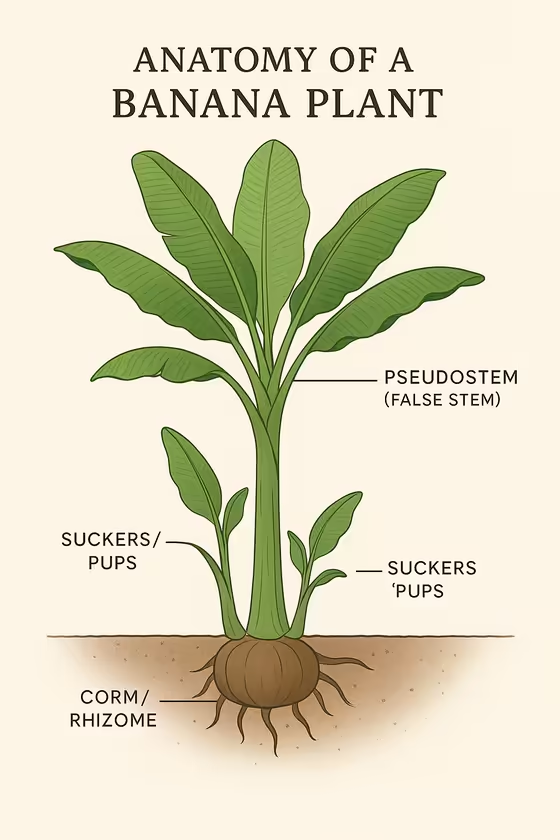
- The Corm (Rhizome): This is the true plant, a big underground stem that stores energy. It has roots that absorb water and nutrients. All new growth starts from the corm.
- The Pseudostem (False Stem): This is the part you see above ground. It supports the leaves and acts like a pathway for the flower stalk to grow up through the middle.
- Leaves: The big, paddle-shaped leaves are like solar panels. They soak up the sun to fuel the plant's fast growth. New leaves unroll from the center looking like a cigar.
- Suckers (Pups): These are new shoots that grow from the corm. This is how the banana plant makes more of itself, creating a little colony of clones.
What You Should Know About It
The banana plant's main strategy is to grow fast, make fruit once, and then send up new shoots from its base.
- Growth Rate: Banana plants grow very quickly. In warm weather, a plant can go from a small shoot to its full height in as little as 9 months . This is why it needs a lot of water and fertilizer to build its huge size so fast.
- Size: Size depends on the type. Some can get as tall as 26 feet. The popular 'Dwarf Cavendish' that people grow at home usually stays around 8 to 10 feet. Cold-hardy types like Musa basjoo can reach 12 to 18 feet in one summer.
-
Life Cycle:
The life of a banana plant is split between its parts.
- The Corm: This is the part that lives for many years underground. It stores energy and keeps making new false stems and pups.
- The Pseudostem: This part is temporary. It flowers and fruits only once. After it produces a bunch of bananas, that false stem is done and will die.
- Does it come back every year? Yes, the underground corm is a perennial and survives. In warm places, it stays green all year. In colder areas, the frost kills the top growth, but the corm will send up new shoots in the spring if protected.
- How many times will one stem make bananas? Only once. Its entire job is to produce one bunch of fruit.
- How long does the whole plant live? The corm can live for many years, maybe even decades. It keeps making new pups, so the plant constantly renews itself.
Picking the Right Banana Plant
Choosing the right plant for your goal is the key to success. You wouldn't want an ornamental type if you want to eat bananas.
There are three main kinds of banana plants for home gardeners: those for fruit, those for looks, and those that can handle the cold.
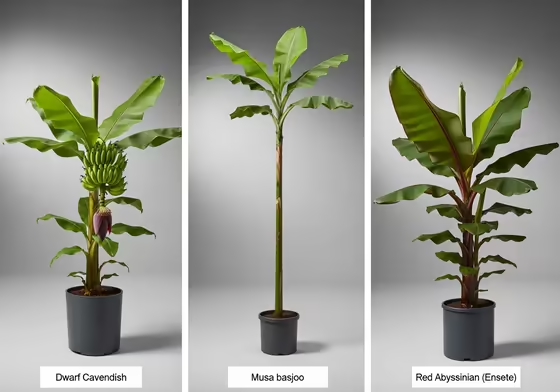
- Fruiting Varieties: These are grown to produce tasty, seedless fruit , like 'Dwarf Cavendish' or 'Lady Finger'.
- Ornamental Varieties: These are grown for their looks, like the colorful 'Red Abyssinian' or the 'Pink Velvet Banana'.
- Cold-Hardy Varieties: These are for people in colder climates who want a tropical look. The most popular one is the 'Japanese Fiber Banana' ( Musa basjoo ).
It's also helpful to know the difference between two main types: Musa and Ensete .
- Genus Musa (True Bananas): These plants, like 'Dwarf Cavendish', make pups from the main corm. This is how they create a colony and keep living year after year.
- Genus Ensete (False Bananas): This includes the 'Red Abyssinian'. These plants do not produce pups and are solitary. The whole plant dies after it flowers, so you have to replace it.
So, if you buy a Musa , you get a plant that will multiply. If you buy an Ensete , you get one single, dramatic plant for a season.
Banana Variety Comparison Guide
| Feature | 'Dwarf Cavendish' (Musa acuminata) | 'Japanese Fiber' (Musa basjoo) | 'Red Abyssinian' (Ensete v. 'Maurelii') |
|---|---|---|---|
| Genus | Musa (True Banana) | Musa (True Banana) | Ensete (False Banana) |
| Primary Use | Fruiting (Edible) | Cold-Hardy Ornamental | Ornamental Foliage |
| Produces Pups? | Yes | Yes | No |
| Fruit | Edible, seedless | Inedible, full of seeds | N/A (Rarely flowers in cold climates) |
| Avg. Height | 8-10 ft. | 12-18 ft. | 10-15 ft. |
| Hardiness | Tender (Zones 8-11) | Root-Hardy (Zone 5-11) | Tender (Zones 8-11) |
Can You Eat the Bananas?
Many people think all banana plants make edible fruit, but that's not true. Some are just for decoration.
-
Can you eat fruit from ornamental plants?
Usually, no. While not poisonous, the fruit from plants like Musa basjoo is considered "inedible." This is because it's full of large, hard seeds . A store-bought banana is soft and seedless because it's a sterile hybrid. -
Key differences to look for when buying:
- For Fruit: Make sure you buy a named edible type, like 'Dwarf Cavendish' or 'Ice Cream'. It will be sold as a "fruiting" banana.
- For Looks: Look for plants known for their leaves, like the colorful 'Red Abyssinian' or the cold-hardy Musa basjoo .
How to Plant Your Banana Plant
Getting Your First Plant
First, you need a plant, and there's a common myth we need to clear up.
-
Can you plant a grocery store banana?
The answer is a definite no. The 'Cavendish' banana from the supermarket is a sterile hybrid. The tiny black dots inside are not real seeds and they will not grow. All 'Cavendish' bananas are clones grown from pups. -
Correct Ways to Get a Plant:
- Pups/Suckers (Easiest): This is the best way for beginners. A "pup" is a small baby plant that grows from the mother plant's base. You just separate it and transplant it.
- Corms/Rhizomes: You can also plant a piece of the underground corm. As long as the piece has a growing "eye" or bud, it can sprout a new plant.
- Seeds (Rare): Growing from seed only works for wild or ornamental types like Ensete . It's a very slow and difficult process and not recommended for beginners.
Planting Outdoors in the Garden
- Sunlight: Banana plants need full sun. They require at least 6 to 8 hours of direct sun every day to grow well and make fruit. Too much shade will result in a weak, stunted plant.
-
Soil Requirements:
- Drainage: This is the most important factor. Banana plants need a lot of water but hate sitting in it. The soil must be well-drained, or the roots will rot.
- Organic Matter: They are heavy feeders and need soil that is very rich. Adding lots of compost or aged manure is a must.
- pH: The soil should be slightly acidic to neutral, with a pH between 5.5 and 7.5.
-
Step-by-Step Planting Guide:

- Pick a Spot: Choose a sunny spot that is protected from strong winds.
- Dig a Large Hole: Dig a hole that is at least a foot deep and wide to loosen the soil around it.
- Amend the Soil: Mix the soil you removed with plenty of compost or well-rotted manure.
- Set the Plant: Place the plant in the hole so the top of its rootball is level with or slightly above the ground.
- Backfill: Fill the hole with your amended soil and gently firm it around the plant.
- Water Deeply: Give the plant a thorough watering to settle the soil.
-
Where NOT to Plant:
- Avoid low spots or areas with heavy clay soil that stay soggy.
- Don't plant in open, windy areas. The leaves will get shredded and the plant could fall over.
- Stay away from salty soils or deep shade.
Planting in a Pot for Indoors or a Patio
- Container Size: The pot size controls the plant's final size. A mature 'Dwarf Cavendish' that you hope will fruit needs a very large pot, like 15 or 20 gallons . You'll need to repot it into a slightly larger container every year or two.
- Potting Mix: The mix must be rich and drain extremely well. A standard potting mix is too heavy. Use a high-quality mix with lots of compost and add perlite or vermiculite to improve drainage.
-
Step-by-Step Potting Instructions:
- Choose a Pot: Pick a pot that has large, plentiful drainage holes. This is a must.
- Add Mix: Fill the bottom third of the pot with your well-draining potting mix.
- Set the Plant: Place the pup in the center of the pot.
- Backfill: Fill the rest of the pot with your mix.
- Water Thoroughly: Water until it flows freely from the drainage holes. Never let the pot sit in a saucer full of water.
Taking Care of Your Banana Plant
Watering
Banana plants are known for being heavy drinkers. Their rapid growth and huge leaves mean they use a lot of water. They are not drought-tolerant and need consistent moisture to stay healthy.
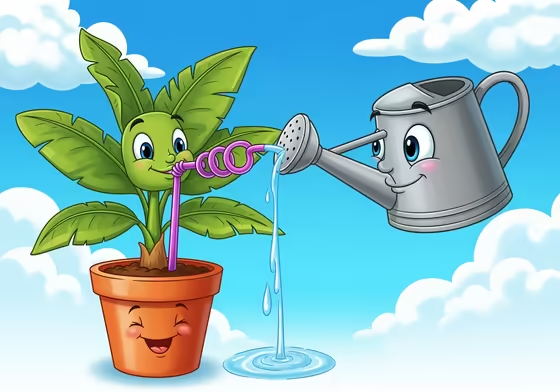
- In-Ground Plants: Water daily for the first week. After that, water deeply every 2-3 days, or whenever the top inch of soil feels dry. In the summer heat, you might need to water every day.
- Potted Plants: These dry out faster and need more frequent watering. Water when the top 1/2 to 1 inch of soil is dry, which will likely be daily in the summer.
- Signs of Overwatering: This is the easiest way to kill a banana plant. Look for yellowing leaves (especially the lower ones), a soft or mushy stem, and smelly, black roots.
- Signs of Underwatering: Symptoms include brown, crispy leaf edges, wilting leaves, and slowed growth.
Fertilizing for Healthy Growth
Banana plants are heavy feeders and need a steady supply of nutrients. They especially need a lot of Potassium (K), which is the key nutrient for flowering and making fruit.
- What to Use: Use a balanced fertilizer that is high in potassium, like one with an 8-10-10 ratio. Rich compost and well-rotted manure are also great.
- Do coffee grounds help? Yes, but they mostly provide nitrogen for leafy growth. Don't rely on them alone, as they don't have the potassium needed for fruit. Use them as a supplement to a balanced fertilizer.
- What about Epsom salt? Epsom salt is magnesium sulfate and should only be used if your plant shows signs of a magnesium deficiency. The main sign is yellowing between the veins on older leaves. Otherwise, adding it can do more harm than good.
- Feeding Schedule: Feed your plant monthly during the spring and summer growing season. Potted plants need feeding more often, maybe every 2-4 weeks with a half-strength liquid fertilizer. Stop fertilizing in the fall and winter.
Pruning and Managing Pups
Pruning helps keep the plant healthy and directs its energy where it's needed most.
- Pruning Leaves: It's a good idea to cut off old leaves that are brown and dead. If a leaf is just turning yellow, it's best to leave it for a while. The plant might be taking back nutrients from it.
-
Should I remove banana pups?
This is an important decision.
- Removing Pups: Taking off extra pups sends all the plant's energy to the main stem. This results in a stronger mother plant and a bigger, better bunch of bananas. You can also transplant the pups to make new plants.
- Leaving Pups: Letting the pups grow creates a fuller, jungle-like clump. It also ensures you always have a replacement plant ready to take over.
- The "Family of Three" Strategy: A good approach is to keep a mother plant, a teenage pup, and a baby pup. This prevents overcrowding while making sure you have a continuous supply of bananas.
- How to Remove a Pup: Wait until a pup is about a foot tall. Choose a strong "sword sucker" with narrow leaves, not a weak "water sucker" with wide leaves. Use a sharp shovel to cut the connection between the mother and the pup, then carefully dig the pup out and replant it.
Getting Your Plant to Make Bananas
Understanding Banana Fruiting

- Timeline: How long it takes to get fruit depends on the climate. In warm, tropical weather, it can be as fast as 9 to 15 months . In cooler areas, it can take 18 months to 3 years.
- Signs of Fruiting: The plant is ready to flower when it reaches its full size and stops making big leaves. A large, purple, teardrop-shaped flower called the "bell" will emerge from the top.
- The Flowering Process: The bell hangs down. As it grows, special leaves called bracts lift to show rows of flowers. The first flowers to appear are female and have tiny baby bananas at their base. Later, male flowers appear at the tip of the bell.
- Are there male and female banana plants? No, there's no such thing as a "male" or "female" plant. Each plant produces both male and female flowers. Once all the female flowers (which become bananas) have been revealed, many gardeners cut off the male part of the bell to send more energy to the fruit.
Harvesting Your Bananas
- When to Harvest: Do not wait for them to turn yellow on the plant. If you do, they might split open or get starchy. Harvest them when they are still green but look plump and rounded.
- How to Harvest: Cut the whole bunch from the stalk and hang it in a cool, shady spot to ripen. You can also cut off one "hand" (cluster) at a time as you need it.
- Timeline from Flower to Harvest: This depends on the heat. It can be as fast as 75 days in hot weather or take up to 6 months in cooler climates.
- What to do After Harvesting: The stem that produced fruit will die. Cut it down to the ground to make room for the next pup. Chop up the old stem and leave it at the base of the plant as mulch; it's full of water and nutrients.
Indoor and Winter Care Tips
Growing Banana Plants Indoors
Banana plants can be good houseplants, but only if you can meet their high demands. They offer a great tropical look, but they have some challenges.
- Light: This is the biggest challenge. They need a huge amount of light. Place them in your sunniest window, ideally one that faces south.
- Humidity: Normal house air is too dry for them, which will cause brown, crispy leaf edges. You must provide extra humidity by misting the leaves daily or using a humidifier.
- Pests: The most common indoor pest is spider mites. They love the dry, warm conditions that banana plants hate.
- Fruit: It is extremely rare for a banana plant to fruit indoors. You should grow it for its leaves, not with the hope of getting bananas.
How to Winterize Your Banana Plant
If you live in a place with freezing winters, this is very important. The method depends on the type of banana plant you have.
Hardy types like Musa basjoo can survive in the ground if protected. Tender types like 'Dwarf Cavendish' or Ensete cannot handle a freeze and must be brought inside.
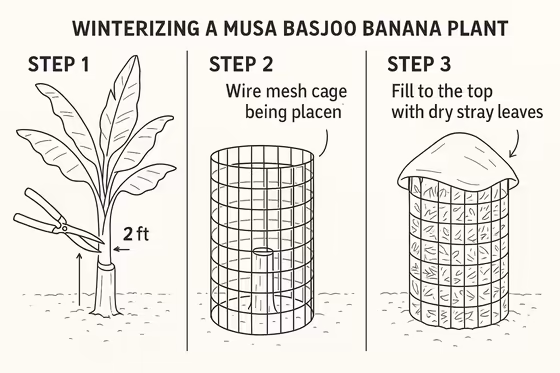
-
For Hardy Bananas in the Ground (Cut and Mulch):
- Wait for the first frost to kill the leaves.
- Cut the stem down, leaving a stump that is 1 to 2 feet tall.
- Build a wire cage around the stump.
- Fill the cage completely with 2 to 3 feet of dry insulation, like straw or shredded leaves.
- Cover the top with a tarp to keep it dry. Wetness will cause rot.
- Uncover everything in the spring after the last frost.
-
For Tender Bananas in Pots (Bring Indoors):
- Dormant Method (Easiest): In the fall, before a freeze, cut the stem down to a 1-foot stump. Move the pot to a cool, dark, frost-free place like a basement. Do not water it at all over the winter. Bring it back outside in the spring.
- Houseplant Method: Bring the whole plant indoors before it gets cold. Treat it like a houseplant in your sunniest window. It will grow slowly, so water it much less and be on the lookout for spider mites.
Common Problems and Questions
Most banana plant problems come from not getting enough of something, usually light, water, nutrients, or root space.
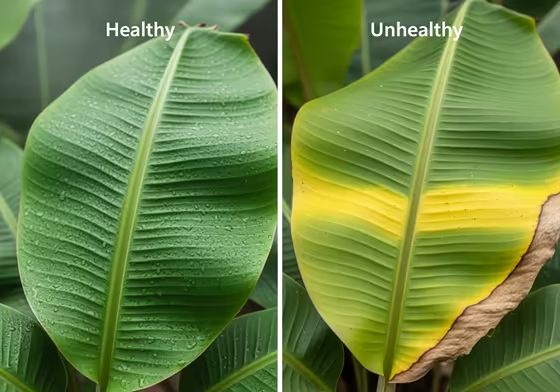
Banana Plant Troubleshooting Guide
| Symptom | Probable Cause(s) | Expert Solution(s) |
|---|---|---|
| Leaves Turning Yellow |
1. Overwatering (Most Likely): Soil is too wet.
2. Needs Nutrients: The plant is hungry. |
1. Stop watering and let the soil dry out. Make sure the pot has good drainage.
2. Feed the plant. If older leaves are yellow, it needs Nitrogen. If the edges are yellow, it needs Potassium. If it's yellow between the veins, it needs Magnesium. |
| Leaves Turning Brown |
1. Underwatering / Low Humidity: Leaf edges are brown and crispy.
2. Sunburn: Looks scorched after moving into bright sun. 3. Cold Damage: Exposed to frost or cold drafts. |
1. Water more often. For indoor plants, mist daily or use a humidifier.
2. Move the plant into full sun slowly over a week. 3. Cut off damaged leaves and protect the plant from cold. |
| Pests (Indoor) |
1. Spider Mites: Tiny dots under the leaves, maybe with fine webs. They love dry air.
2. Aphids / Mealybugs: Small, visible insects. |
1. Raise the humidity. Wipe the leaves with a damp cloth and spray with insecticidal soap or neem oil.
2. Spray the plant with a strong jet of water. Treat with insecticidal soap. |
| Plant Not Growing |
1. Lack of Nutrients: It's starving.
2. Pot-Bound: The pot is too small. 3. Not Enough Light: Needs 6-8+ hours of sun. 4. Too Many Pups: They are draining the main plant's energy. |
1. Start feeding it monthly with a high-potassium fertilizer.
2. Repot into a bigger container. 3. Move it to a sunnier spot. 4. Remove the extra pups, leaving only one or two. |
-
Things to Consider Before Planting
Banana plants are great, but they are a big commitment. Here are a few things to think about.- They Get BIG: Even "dwarf" types grow 8-10 feet tall. This is not a small plant.
- They Need a Lot of Resources: They are not "plant it and forget it" type plants. They demand a lot of water and fertilizer.
- They Spread: Musa types will spread with pups. What starts as one plant can become a large clump in a few years, so give it plenty of space.
- Winter Work (In Cold Climates): If you live where it freezes, you will have to do some work every year to either dig it up or cut it back and protect it.